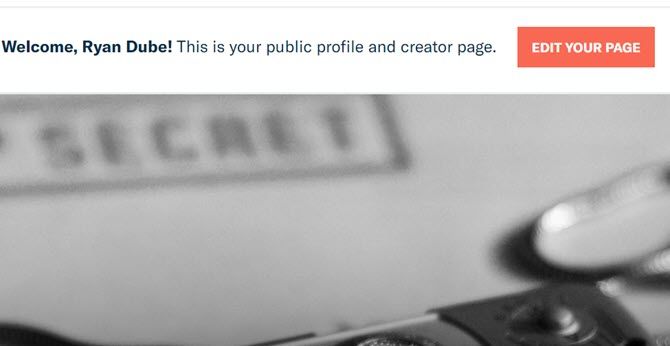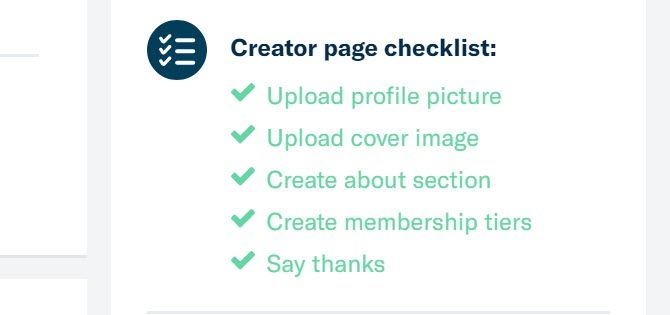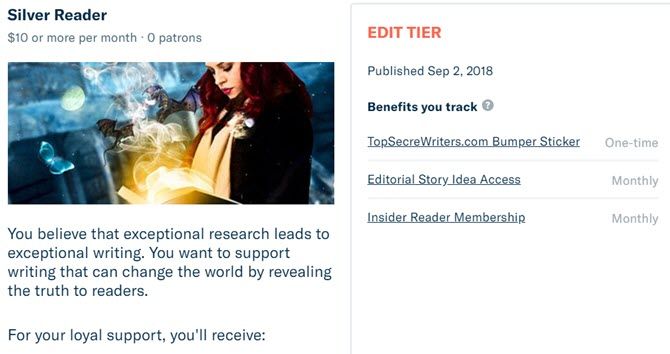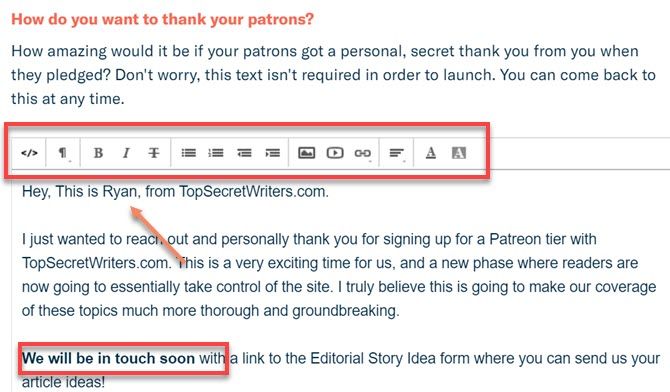
Thanks to Patreon, the concept of the “starving artist” is one that may soon become a thing of the past.
Patreon is a way for people, whether they be fans, readers, or viewers, to “sponsor” your creative work every month. Your fans sign up to become a “patron” of your work by committing anything from one dollar to several hundred dollars, depending on the tier they choose.
In this article, we’ll help you set up a Patreon page and give you a few tips to make it successful.
How Patreon Works
Unlike the “donation” approach many creatives use, with Patreon your fans commit to donating a monthly payment to your cause. There are Patreon creators who make a few hundred dollars each month, while others tens of thousands of dollars each month.
The following are some of the popular creators who used Patreon to make over $150,000 in 2016.
- Kinda Funny: A well known YouTube channel with over 200,000 subscribers, Kinda Funny creates special content for Patreon members.
- Amanda Palmer: Amanda is an artist of many works, from performance art and music to podcasts and documentaries. Her eclectic mix of art has brought in over 11,000 patrons at the time of writing.
- SciShow: This creator is proof that people enjoy educational art as well. SciShow creates YouTube videos about science, and their Patreon community currently brings in almost $20,000 a month.
- Peter Hollens: A music creator who produces amazing a capella productions for his fans, Peter’s 4,000 patrons prove that you don’t have to be a starving artist to do what you love to do.
- WaitButWhy: This is one of the first blogs that started using Patreon to offer readers an ad-free reading experience. The experiment was a glowing success. Tim Urban and Andrew Finn, the creators of WaitButWhy, are currently the most successful Patreon-funded bloggers to date.
These are people who have created a living income by starting a side hustle and removing the income middlemen like advertisers. Instead, they’re directly leaning on their fans to support their work.
If you’re a creator who wants to focus more on your creative art and less on trying to figure out where your next paycheck comes from, let’s take a look at how you can set up your own Patreon page.
Creating Your Patreon Page
The first step in creating your Patreon is to design and write your initial Patreon page. This should be a compelling writeup that will sell your fans on the idea of contributing to your cause.
When you first open your account, you’ll see a button to create your overview page.

This is just like writing a blog post, but remember that you’re essentially writing sales copy. So make a compelling case to your fans as to why they should contribute to your work.
A good approach to this is to review some of the overview pages for top-earning creators on Patreon. Use their overview page as a general format for your own.
Overview Page Outline
A good Overview page will have the following structure.
- Introduction: Briefly tell your potential patrons who you are and the work that you do.
- Explain the Why: Tell your story as to why you’re turning to a fan-supported approach.
- Tell Them the How: If someone is going to financially support you, they’ll want to know where the money is going to go. Be honest and straightforward about the costs involved in doing what you do.
- Thank Them: Close off with a thank you to those who are willing to support your work.
There is also the option to include an “Intro Video”. This is a great way to introduce yourself to your potential patrons and let them see the actual face of the person they’re supporting.
If you aren’t already one of the popular YouTube personalities with an existing fan base, this is a critical piece of your overview page.
A few other options you can include on your Overview page:
- Links to your social profiles
- A Google Analytics ID so you can monitor how many people visit your Patreon page
- An RSS audio feed for you to post exclusive audio content to your patrons
- Enable access to your Discord server to add roles for patrons to access your benefits
Once you’ve created your well-crafted overview page, it’s time to think about the contribution tiers. You’ll need to decide what rewards you want to give your patrons.
How Patreon Membership Tiers Work
On the right side of the Overview creation page, you’ll see a checklist. By this point you should have everything checked off in green up until Create membership tiers.
Click on this link to move on to the next step.

When considering each tier for subscriptions, offer enough to entice subscribers. However, don’t offer so much that you can’t keep up with things.
Free products are great so long as the cost of the product and shipping is covered by the donation. The most popular tier rewards are exclusive access to content.
To create each tier, just click the Edit Tier link on the right side of the screen. Fill in a good description describing the benefits of that tier, and make sure to add the benefits to the list on the right side as well.

You could add contributors to a newsletter list and give them early access (or discounted access) to whatever work you create. Or you could produce exclusive content just for patrons donating at particular tiers.
Typical Patreon Membership Tier Structure
This gives your patrons a feeling like they are contributing to your work, or gaining some benefit from their monthly contribution. Without a reward that feels valuable to subscribers, it’s going to be much harder growing your patron community.
The most common tier structure looks like this:
- The first tier is usually between $1 to $5 a month
- Make the second tier $10 to $25 a month
- Tier 3 might be something like $50 to $100 a month
Upper tiers can range anywhere from $300 upwards of $1000 a month. But the rewards for those should be substantial. Make sure you put a plan and some sort of automated solution in place to provide those rewards to the people who subscribe.
For example, you might add the emails for those top tier subscribers to a special email list where you regularly send high-value discounts, special gifts, and other valuable benefits. It’s important to make them feel like they’re getting value from those contributions. Otherwise they’ll cancel their contributions.
Don’t Forget to Send Thank You Emails
The next item on the checklist is to “Say Thanks”. This is where you craft an email saying thanks to every patron who has decided to contribute to your work. Give this email a lot of thought, because it’s the first personal response they’ll get from you once they’ve made their commitment.

The email entry form lets you format the email just like you normally would. Make sure to introduce yourself to make it appear as though it’s a personal one-to-one thank you letter.
Also promise to follow up. Each tier should have an individualized email that you’ll eventually send providing the subscriber with links to any special access forms or private web pages you’ve set up just for them.
How to Promote Your Patreon Page
While seeing others who are so successful using Patreon as a source of income is encouraging, replicating that success won’t come easy. Especially if you haven’t already built a fanbase on another platform.
Just creating your Patreon overview page and tiers isn’t going to bring in all of your patrons. You need to promote your new Patreon page using every channel at your disposal.
Here are a few ideas to accomplish that:
- Create Patreon blog posts: It’s important to create frequent blog posts on Patreon. Make many of those accessible only to patrons. This will encourage people to at least commit to the minimum amount so they can read your posts.
- Social Media: Promote your patreon page on every social platform you have an account on. Having existing followers there gives you access to a lot of people who’ve already expressed interest in your work.
- Newsletter: If you’ve developed a large email subscriber list over time, this is one of your best sources for potential patrons. These are people who’ve already subscribed to your work, so committing a small financial donation every month is not a very big leap.
- Blog Posts: If you already have a blog, take full advantage of that audience by posting regular blog updates about your Patreon campaign and the growing community there. Entice your readers to get involved.
- Community: You’ll notice a community link on your Patreon page. This is where you can regularly engage with people who’ve signed up as patrons. Staying active here is critical to keeping and growing your patron community.
- YouTube: If you don’t already have a YouTube channel, consider creating one to present yourself to the world. Seeing your face and hearing you talk about your work will encourage even more people to commit to supporting you.
- Free Stuff: Marketers know that people love free stuff. The most powerful marketing campaigns are built on offering things like free eBooks. Offer this free eBook or other free content through any of the channels above. Also make sure to promote your Patreon page in that free content.
Stay Engaged With Patrons!
The most successful people on Patreon have built their audiences by knowing how to promote themselves. They’re not just active in their Patreon community, but also regularly encourage Patreon donations in everything they do. This is the only real way to build your list of Patreon contributors.
If you’re really serious about growing your list of patrons, you should consider supercharging your email marketing to boost your audience even faster. Every effort counts.
Read the full article: How to Launch a Successful Patreon Page
Read Full Article
No comments:
Post a Comment